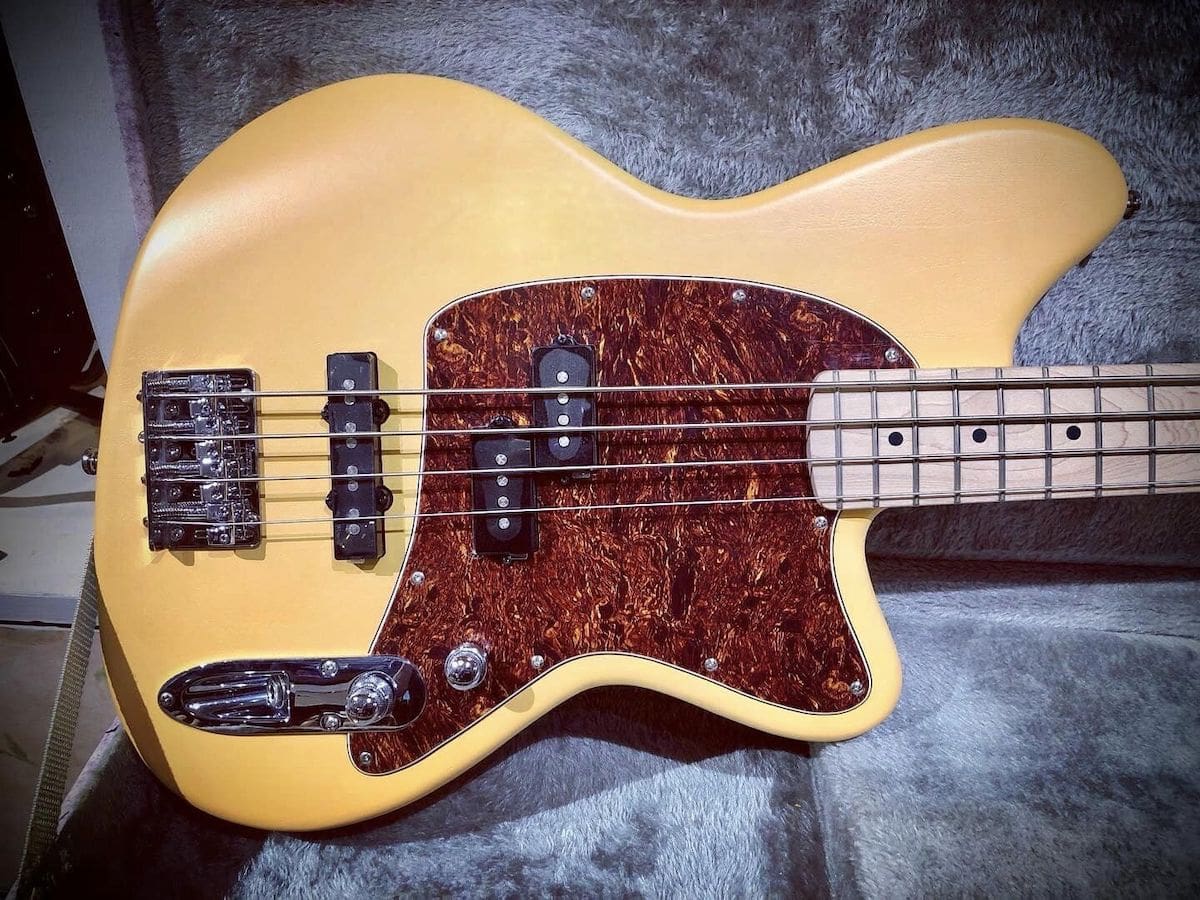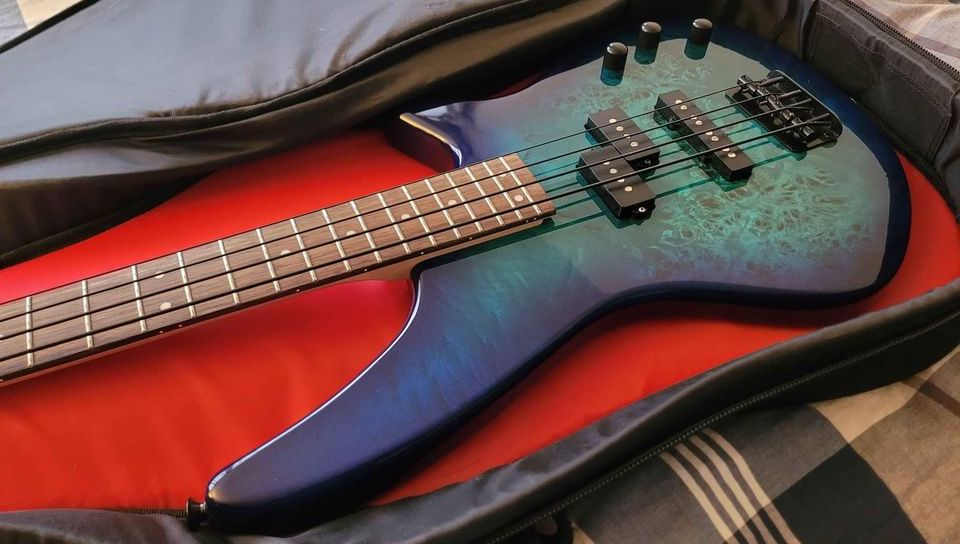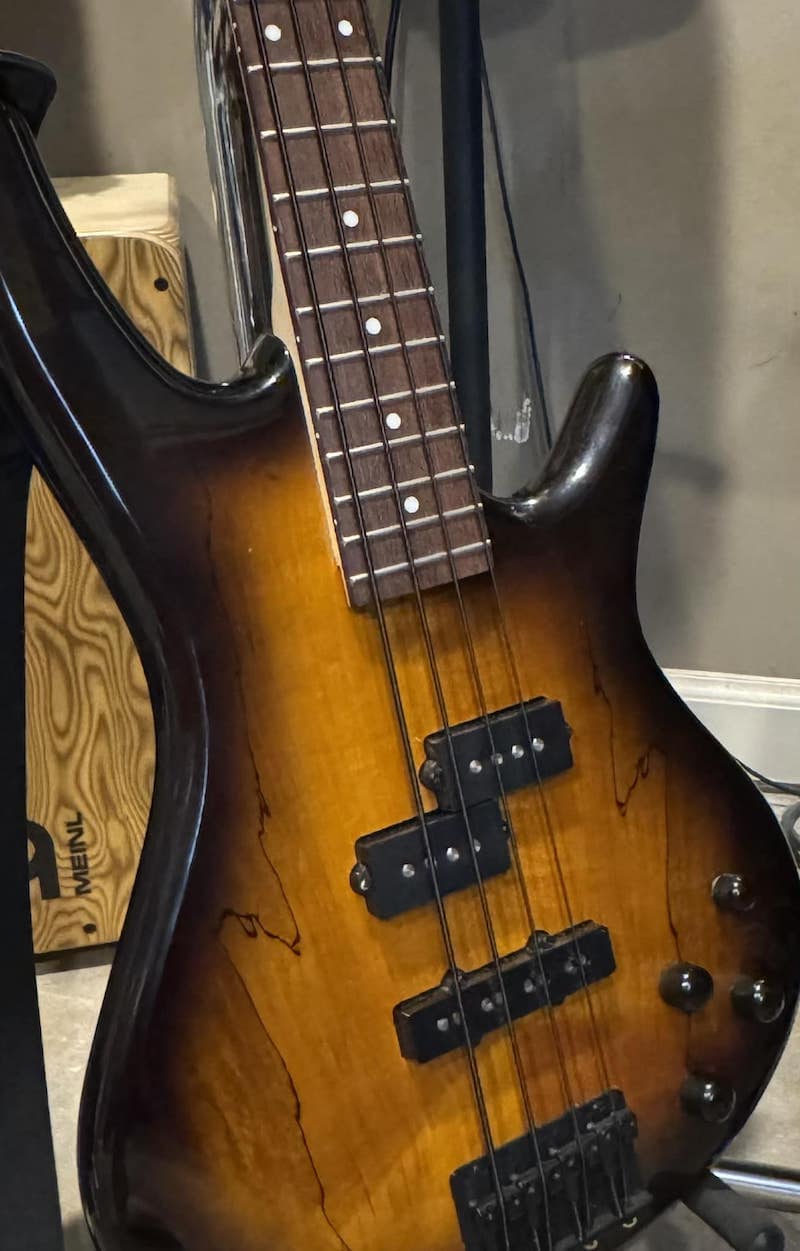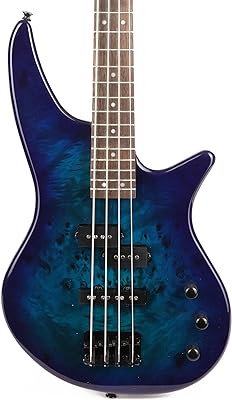Whether you’re an advanced bassist looking for a reliable backup instrument or a beginner just getting to grips with the instrument, odds are there’s a great budget bass out there for you.
At the price range under $300, the big manufacturers are finding ever more innovative ways to keep pricing down. Most of the time, that means using cheaper electronics, including pickups.
It often also extends to country of origin, quality of wood, and the additional appointments like binding and expensive fret markers that typically come with higher-end instruments.
Of course, a $250 Mexican-made Squier bass isn’t going to compete with a Californian $2500 American-made Fender, even if the factories are only a few hours apart. Rumor has it that some workers even pull double duty at both factories!
Top 3 - Budget Bass Guitars
Preview | Product | Price |
|---|---|---|
However, that does not mean that budget basses aren’t worth your time and attention. With some love and attention, you can find a reliable instrument that you won’t stress about taking on the road or whipping out to practice at home.
6 Best Basses Under $300 - Affordable Bass Guitars
Table of Contents
1. Squier Affinity PJ Precision Bass
Of course, the Precision Bass is one of the bestselling basses ever produced. Between the P bass and the J bass, Fender introduced the PJ bass to the masses.
It’s hard to think of now, but before the P and J basses were introduced to the market, most bass players still used massive classical-style double basses.
Picking up this bass, the first thing I noticed was its weight, or lack thereof. The poplar body and maple neck make this a very light bass indeed. Picking it up in a hard case, the case almost felt empty!

Squier Affinity Precision Bass PJ
The laurel fretboard feels a little dry under your fingers, but that’s nothing a little lemon oil and playing time won’t fix. The frets aren’t terribly high, and if you plan to tour heavily with this bass, they might need replacing in a few years’ time, particularly if you’re a heavy player like me.
The star of the show with this gorgeous PJ Bass is the combination of single-coil Precision and Jazz pickups. The pair conjure classic warm, rounded Fender bass tones. Tweaking of the volume and tone knobs conjured a suitably “woofy” Motown/classic country bass tone.
You know the one: the gorgeous bass intro to Billy Ocean’s “Love Really Hurts Without You.”
Some more tweaking and the addition of a nice hefty pick allowed for some mid-forward metal-style playing, but without a setup to lower the action on this bass, Steve Harris style runs are going to be pretty difficult.
The Squier Affinity series has offered some excellent affordable versions of Fender’s most iconic silhouettes, and the Affinity PJ Bass is no exception. Overall, a great bass for the price.
2. Yamaha TRBX174
The quality of Yamaha guitars was one of the guitar world’s best-kept secrets for years. These days the Japanese instrument/motorbike giant is a very popular choice for working musicians in the market for a reliable, inexpensive instrument.
The Yamaha TRBX174 offers exactly that. This bass is a total workhorse. Its mahogany body is a little on the heavier side, surprisingly for a Japanese builder that typically caters to those with smaller frames.

Yamaha TRBX174
The neck is comfortably slender, too. It’s almost Telecaster-like in its profile. I’d strongly recommend this bass to a teenager learning the instrument as it will feel extremely comfortable for those with smaller hands.
The TRBX174 actually has a lot of growl in its tone, and feels like it was meant for heavier music. It’s not the full-throated Gibson Thunderbird/Grabber growl of, say, the early KISS records, but it definitely feels more aggressive than a Fender-style bass, despite the Strat-esque body shape.
With playability as the clear priority for Yamaha in building this instrument, it feels like an excellent bass to learn on. It looks good enough in a high-gloss finish to take on stage, too, and feels sturdy enough to handle the rigors of your average club show.
If, like me, you’re primarily a guitar player who happens to pick up a bass now and again, this bass would be a great choice. I say this because the neck feels so similar to that of an electric guitar.
While it lacks the shorter scale length that most guitarists will be used to, I can see this being an easy bass to switch to between sets after playing electric guitar.
3. Ibanez Talman TMB100M
Ibanez is probably the biggest name in Japanese guitar building. They have a stellar reputation to uphold, and the addition of their budget-friendly Tele-esque Talman body shape to the bass lineup is a very welcome one.
The Ibanez Talman bass clearly wants to be a Telecaster. The butterscotch finish, tortoiseshell pickguard, and unadorned maple neck are pure Tele in looks. The Talman shape has extended to slimline acoustic guitars in the past, once again evoking a Telecaster-esque appearance.

Ibanez Talman TMB100M
Upon picking up this bass, it’s apparent that it’s intended for guitar players who dabble in bass. As someone who primarily plays guitar, not bass, this felt perfect.
The neck is very comfortable for playing guitar. It’s not exactly the Fender C profile, but it’s close enough that the transition won’t be tricky.
The maple neck feels great in your hand (zero roughness), and the medium frets respond well to minimal pressure without buzzing or fretting out.
The lightweight body feels almost hollow. I could easily see myself playing this bass at a long gig, standing for hours on end.
It’s clear that comfort was the main priority in building the Talman bass, a great consideration from Ibanez.
Instruments in this price range are typically embraced by beginners and intermediate players. By emphasizing player comfort with the neck and lightweight body, Ibanez are catering very well to early players.
Also like the Telecaster, which can be seen in pretty much all genres of music, this bass is astonishingly versatile in its range of tones. The two-band EQ makes this much easier. It’s easy to adjust the tone for various genres. This would be a great bass to play in a versatile cover band.
4. Squier Affinity Jazz Bass V
Fender’s Jazz bass may have originally been aimed at advanced jazz musicians, but has found itself in the hands of players of all abilities and genres.
The Affinity Jazz Bass V is not, as the name might suggest, a foray into the Gibson V shape. It’s a five-string bass, and at under $300, it might be the best value for money 5-string bass on the market today.

Squier Affinity Jazz Bass V
The additional string is on the higher end, so those looking for subterranean bass tones ought to look elsewhere. For extended range into baritone guitar territory, however, this bass is a great option.
Upon strapping on this bass and plucking out a few notes, the first thing I noticed was that droning Lemmy-style chords actually resonated. I could feel the bass resonating against my torso as I played it, something I’ve only really experienced with hollow-bodied electric guitars in the past.
I’m not sure if that was unique to the bass I tried, but this felt like it added to the bass’ welcoming, warm sound. It was easy to conjure warm, articulate bass tones from the Jazz bass. The neck was a little wider than I normally like for a Jazz bass to accommodate the additional string, but comfortable enough to play.
Despite all this, the best thing about the Affinity Jazz was its nice low action. Many basses come from the factory with higher action, particularly in this price range. However, this bass’ action was low enough to facilitate a few slinky Phil Lynott-style fills.
If you’re interested in a backup for your main 5-string or to dip a toe in the 5-string waters, the Affinity Jazz V would be a great choice.
5. Jackson JS Series Spectra JS2P
Jackson are best known for their shred-ready guitars and basses, widely used by the most decorated heroes of the metal and hard rock genres. The JS2P bass, with its aggressive shape, 24-fret neck, and ready-to-rock “P and J style” pickups, is clearly built to rock.

Jackson Spectra JS2P
Upon first picking this bass up, I was struck by the neck radius. When millimeters matter for high-speed playing, you get these sorts of supermodel-thin necks. I prefer a bit of heft to my instrument necks, but I’ll concede that rapidfire runs were very, very easy on this bass.
While the bass isn’t so lightweight that you’d never get tired playing it standing up, it’s definitely not too heavy. You wouldn’t need a weight-relieving strap to play it at a gig, but it might get a bit tiresome for smaller-framed individuals at a gig lasting a few hours.
One other great feature of this bass is the three-band active EQ. It made tone sculpting very easy. I was able to dial in an aggressive, mid-forward 80s metal tone pretty easily.
The laurel fretboard does feel a little dry under my fingers. I like unfinished fretboards, and keep lemon oil handy at home at all times, but you’ll need to oil the fretboard up yourself to get maximum playability out of this instrument.
While I understand that Jackson had to make some concessions to get this bass to a budget-friendly price point, when playability and shredding is the clear aim of an instrument, I feel like the fretboard shouldn’t be dry straight out of the box.
I’d recommend this bass to those with heavier tastes in music looking to learn the instrument.
6. Ibanez Gio GSR200SMNGT
It’s no wonder that Ibanez instruments are prized by the leading shredders in the world today. But how do their basses stack up?
The Ibanez Gio GSR200SMNGT feels like a student’s first “nice” instrument, but it’s priced like a beginner instrument. I don’t know where Ibanez were saving money on this bass, because it feels like a more expensive instrument in just about every way.

My old Ibanez GSR200.
It’s definitely built for those looking to build their advanced playing chops. The neck is smooth and comfortable, and the body’s rounded, welcoming contours feel like a memory foam mattress against your torso.
The bass looks gorgeous, with a lovely sunburst effect in the finish. It plays beautifully: the neck feels great in my hand. The action was a little low out of the box, and there was some buzzing in certain spots. However, even before adjusting the action, controlling my left-hand pressure largely addressed this issue, as did playing less hard with my right hand.
I usually play bass with a pick, and this bass really accentuates pick attack.
I really love the sound of the pick hitting the string, and the capacity to hear this reproduced through an amp, and have the bass’ response vary based on my picking pressure, is a feature typically reserved for more high-end instruments.
This bass is clearly intended for beginner players looking to learn on an instrument that makes practicing fun. I could see any learner bassist enjoying their foray into more advanced techniques on this Ibanez bass.
Basically, if you’re a learner or intermediate bassist inspired by Billy Sheehan or Doug Wimbish, this bass offers a tremendous jumping off point as you pursue your virtuoso dreams.
Buying Guide on Affordable Bass Guitars
While your own choices and preferences should always guide your choice of an instrument, there are certain factors that play a huge role in determining the quality, and therefore the value for money, you get from a budget bass.
Some might disagree, but in my opinion, playability is the most important feature of a budget instrument. Tone is important - a musical instrument has to sound good to make you want to play it - but you can remedy a bass’ muddy or tinny tone with a pickup upgrade.
It’s harder (and usually much more expensive) to swap out an uncomfortable neck, or a body shape that cuts into your forearm.
I also prize playability in budget instruments because they’re usually aimed at learners. Why would, when your skills are the least they’ll ever be, you play an instrument that’s difficult to play?
Surely beginners are better off being motivated to practice by an instrument that plays well instead of them having to fight it every time they pick it up.
My chief criteria for budget basses are:
- Playability (weight, neck, body, frets)
- Tone (wood, pickups)
- Use (what you’ll be using the bass for)
Playability
Chief among your concerns should be how good the bass feels when you play it.
You can reset action that is too high or too low. However, you want a bass that doesn’t have any buzzy or fizzy “dead zones” on the neck, or uncomfortable frets.
Some budget basses have pickups and metal bridges that stand too proud and can be uncomfortable for your hands. Others are too heavy, or have necks that don’t feel good in your hand.
All the bass guitars I listed in the above article prioritize player comfort. However, your experience of a bass will vary based on your frame, hand size, and playing style. What’s comfortable for you won’t always be comfortable for another player.
Even the fretboard wood can affect your playing experience. For that reason, it’s best to get to grips with the right physical features for the style you plan to play.
Tone
Tone comes from two main factors: a bass’ pickups and the woods used in its construction.
While it’s great if a bass comes with nice-sounding pickups, few budget basses have high-end pickups installed. The more expensive pickups will cost more than any of the basses on this list!
A bass that sounds good to your ear, and with tone that’s easy to sculpt via onboard controls, will motivate you to play more than one that does not.
The woods used in the instrument’s construction also massively affect its tone. Most basses are made from any combination of maple, ash, poplar, and mahogany, although some other woods like sapele are becoming more popular.
You won’t often see more exotic woods on a budget bass. Mahogany has a darker, mid-heavy sound, while maple, ash, and poplar have more snap and treble to their tone.
How Will You Use It?
The final question is what you plan to use the bass for. Is it for practice at home, or for gigs? Will you record with it? Will it be a main instrument, or used as a backup?
How you plan to use the instrument is the final, but equally important, factor in deciding on a new instrument. A bass well suited to clean technique practice might not always dirty up nicely enough for a loud doom fuzz band.
Most bass guitars are versatile enough to cover many genres and use cases, but it’s always worth considering your unique situation.
Final Word
Whatever your needs and tastes in bass guitars, there’s a budget bass out there for you.
Any of the basses on this list would make a fine addition to any bass player’s collection, whether you’re just a beginner, a guitar player who switches to low end for occasional gigs, or a seasoned pro looking for an affordable, reliable backup to your main instrument.







I have been considering adding an Ibanez TMB30 to my collection.
I have been getting into budget basses the last few years, after switching to short scales and not wanting to break the bank while testing the waters. While not under your $300 limit, the Gretsch Jet II is a very comfortable, good sounding bass. And the one that really surprised me was the Ibanez Mikro! And it’s under $200. It sounds and plays great and the hardware is far better than I even expected.